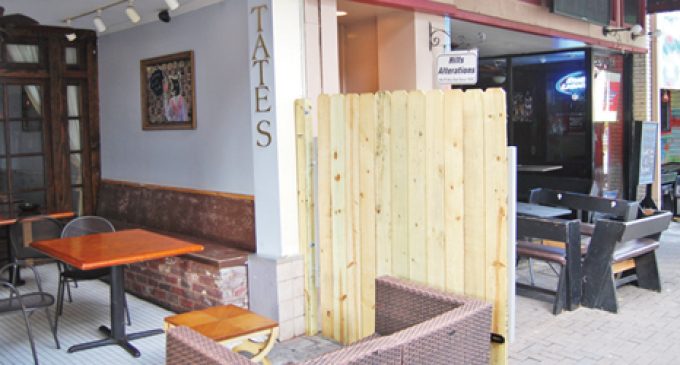Controversial ‘wall’ removed

(Above: The Tate’s ‘wall’ as it looked last week. Part of Wingz and Spirtz’s patio – with the black benches – can also be seen)
Critics say bar tried to shield itself from neighbor’s black patrons
A wooden, retractable wall at Tate’s Craft Cocktails that shielded its front patio from that of neighboring Wingz and Spirtz Sports Bar has been removed after months of speculation about it.
Tate’s said the wall – a more than six-foot tall picket-fence-like structure – was erected as a noise barrier. Wingz and Spirtz owner Souphab “Soup” Daoheang and many of his customers maintain it went up to shield Tate’s largely white, professional customer base from the overwhelmingly black clientele who frequent the sports bar.
Last week, when the wall was still up, Daoheang said he felt his sports bar, one of several watering holes along Fourth Street, has not been embraced by other downtown businesses, especially Tate’s, because of a misconception that the bar is dangerous and rowdy. He said the race of his customers is fueling those stereotypes. The erection of the wall earlier this year was a manifestation of that bias and misperception, he said.
“I find it offensive for both me and my costumers,” Daoheang said of the wall. “Their actions speak much louder than words.”
Tate’s owner John Tate denied that racial bias played a role in the decision to put up the wall. Tate said it was erected as a noise barrier to not only shield both establishments from each other’s noise, but also reduce noise for residents in the nearby One Park Vista condos, who Tate said had called his bar to complain about clamor.
The Chronicle first inquired about the wall last Thursday. A manager at Tate’s said owner Tate was out of the country but that a message about the inquiry would be sent to him. The wall was removed Sunday. Tate said the timing was fortuitous, as he had no idea that The Chronicle was planning a story about it.
Tate said he removed the “ugly fence” because it did not suit Tate’s aesthetics. Some of his customers have already complained about its absence, he said.
“It was a noise issue; our customers, complained about the noise coming from next door,” Tate said. “It was effective but it just isn’t consistent with us.”
Daoheang – founder and former owner of Downtown Thai, another downtown Fourth Street business – had tried a variety of bar/restaurants in the spot that Wingz now occupies. He calls the roughly one year-old sports bar a success. It serves its signature chicken wings and other dishes and screens a variety of sporting events on large television screens from 6 p.m. until midnight. Late on Friday and Saturday nights (around 11:30), the bar transforms into a night club, complete with a DJ, and closes at 2 a.m.
While there is talk of personal enmity toward Daoheang from other downtown businessowners, he was Mr. Popular last week as he sat outside of his bar. A steady and diverse stream of customers greeted him. He asked them all if they felt safe at his bar; all said they did; some where surprised the question even needed to be asked.
Daoheang also asked them why they thought the wall at Tate’s was erected. Most suspected it was because of the race and class differences between the two bars’ patrons.
“It comes across as ‘We’re not like that place,’ as if this place has a negative perception,” said Eric Price, a Winston-Salem State University student who frequents both Tate’s and Wingz. “It’s kind of telling, because if you look down this block of Fourth Street, there’s only one wall on the entire block.”
Tate, a financial consultant who also owns The Honey Pot restaurant adjacent to Tate’s, said his bar welcomes everyone and has a diverse clientele that reflects the population of the city. He said Tate’s has no dress code and a menu with a variety of price points to attract all-comers. The bar, which opened four and a half years ago, serves cocktails and draft beers from 4 p.m. until 2 a.m and features performances by local musicians on Tuesday nights.
Though Tate maintains the wall was only about reducing noise, he said there were some incidents at Wingz that did concern him.
Daoheang said he has a zero tolerance policy for trouble and, like several other area bars, started using uniformed off-duty police officers for security on club nights. He said a few incidents that have happened along the street have been attributed to his bar only because of proximity. He maintains that there are rarely problems with his costumers and that onlookers sometimes assume the opposite when they see large groups of black people congregated.
According to Police to Citizen (P2C), an online incidents records system, over a one year period, all the bars on that block of Fourth Street have had calls for service for similar issues, including theft of cell phones and wallets, panhandling, disorderly conduct and the rare assault.
The amount of calls for service attributed directly to Wingz was only slightly higher than those attributed to Tate’s. There were six separate incidents attributed to the street directly in front of Wingz.
On Monday, Daoheang said he was glad to see the wall gone.
“It opens up the sidewalk; it makes the whole block feel welcoming,” he said. “It’s very pleasant and makes downtown wide open again.”













